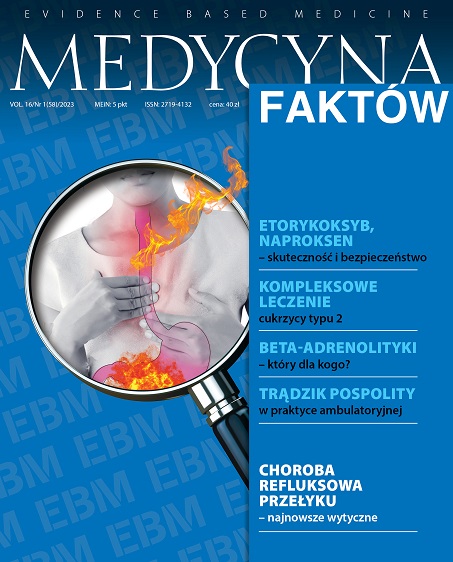5 reasons why it is worth using a combination of estradiol and dydrogesterone in menopausal hormone therapy Review article
Main Article Content
Abstract
Menopausal hormone therapy is an effective method of alleviating menopausal symptoms. There are two types of menopausal hormone therapy: estrogen monotherapy and combined estrogen and progesterone therapy. There are many preparations available on the market, differing both in active substances and schedules, doses and routes of their administration. This allows for individualization of therapy and adapting it to the needs of a given patient. This paper presents the characteristics of combined therapy estradiol + dydrogesterone and the possibilities of their use in practice.
Article Details
How to Cite
Skrzypulec-Plinta, V., & Zborowska, K. (2023). 5 reasons why it is worth using a combination of estradiol and dydrogesterone in menopausal hormone therapy. Medycyna Faktow (J EBM), 16(1(58), 60-62. https://doi.org/10.24292/01.MF.0123.10
Issue
Section
Articles
Copyright © by Medical Education. All rights reserved.
References
1. Woods NF, Mitchell ES. Symptoms during the perimenopause: prevalence, severity, trajectory, and significance in women’s lives. Am J Med. 2005;118(suppl 12B): 14-24.
2. Ren M, Ruan X, Gu L et al. Ultra-low-dose estradiol and dydrogesterone: a phase III study for vasomotor symptoms in China. Climacteric. 2022; 25(3): 286-92.
3. Stevenson JC, Durand G, Kahler E et al. Oral ultra-low dose continuous combined hormone replacement therapy with 0.5 mg 17β-oestradiol and 2.5 mg dydrogesterone for the treatment of vasomotor symptoms: results from a double-blind, controlled study. Maturitas. 2010; 67(3): 227-32.
4. Fournier A, Berrino F, Clavel-Chapelon F. Unequal risks for breast cancer associated with different hormone replacement therapies: results from the E3N cohort study. Breast Cancer Res Treat. 2008; 107(1): 103-11.
5. Abenhaim HA, Suissa S, Azoulay L et al. Menopausal hormone therapy formulation and breast cancer risk. Obstet Gynecol. 2022; 139(6): 1103-110.
6. von Schoultz E, Rutqvist LE; Stockholm Breast Cancer Study Group. Menopausal hormone therapy after breast cancer: the Stockholm randomized trial. J Natl Cancer Inst. 2005; 97(7): 533-5.
7. Vinogradova Y, Coupland C, Hippisley-Cox J. Use of hormone replacement therapy and risk of breast cancer: nested case-control studies using the QResearch and CPRD databases. BMJ. 2020; 371: m3873.
8. Schneider C, Jick SS, Meier CR. Risk of cardiovascular outcomes in users of estradiol/dydrogesterone or other HRT preparations. Climacteric. 2009; 12(5): 445-53.
9. Christenson ES, Jiang X, Kagan R et al. Osteoporosis management in post-menopausal women. Minerva Ginecol. 2012; 64(3): 181-94.
10. Stevenson JC, Panay N, Pexman-Fieth C. Oral estradiol and dydrogesterone combination therapy in postmenopausal women: review of efficacy and safety. Maturitas. 2013; 76(1): 10-21.
11. van de Weijer PH, Scholten PC, van der Mooren MJ et al. Bleeding patterns and endometrial histology during administration of low-dose estradiol sequentially combined with dydrogesterone. Climacteric. 1999; 2(2): 101-9.
12. Ferenczy A, Gelfand MM. Endometrial histology and bleeding patterns in post-menopausal women taking sequential, combined estradiol and dydrogesterone. Maturitas. 1997; 26(3): 219-26.
13. Ferenczy A, Gelfand MM, van de Weijer PH et al. Endometrial safety and bleeding patterns during a 2-year study of 1 or 2 mg 17 beta-estradiol combined with sequential 5-20 mg dydrogesterone. Climacteric. 2002; 5(1): 26-35.
14. Quereux C, Pornel B, Bergeron C et al. Continuous combined hormone replacement therapy with 1 mg 17beta-oestradiol and 5 mg dydrogesterone (Femoston-conti): endometrial safety and bleeding profile. Maturitas. 2006; 53(3): 299-305.
15. Jaakkola S, Lyytinen H, Pukkala E et al. Endometrial cancer in postmenopausal women using estradiol-progestin therapy. Obstet Gynecol. 2009; 114(6): 1197-204.
2. Ren M, Ruan X, Gu L et al. Ultra-low-dose estradiol and dydrogesterone: a phase III study for vasomotor symptoms in China. Climacteric. 2022; 25(3): 286-92.
3. Stevenson JC, Durand G, Kahler E et al. Oral ultra-low dose continuous combined hormone replacement therapy with 0.5 mg 17β-oestradiol and 2.5 mg dydrogesterone for the treatment of vasomotor symptoms: results from a double-blind, controlled study. Maturitas. 2010; 67(3): 227-32.
4. Fournier A, Berrino F, Clavel-Chapelon F. Unequal risks for breast cancer associated with different hormone replacement therapies: results from the E3N cohort study. Breast Cancer Res Treat. 2008; 107(1): 103-11.
5. Abenhaim HA, Suissa S, Azoulay L et al. Menopausal hormone therapy formulation and breast cancer risk. Obstet Gynecol. 2022; 139(6): 1103-110.
6. von Schoultz E, Rutqvist LE; Stockholm Breast Cancer Study Group. Menopausal hormone therapy after breast cancer: the Stockholm randomized trial. J Natl Cancer Inst. 2005; 97(7): 533-5.
7. Vinogradova Y, Coupland C, Hippisley-Cox J. Use of hormone replacement therapy and risk of breast cancer: nested case-control studies using the QResearch and CPRD databases. BMJ. 2020; 371: m3873.
8. Schneider C, Jick SS, Meier CR. Risk of cardiovascular outcomes in users of estradiol/dydrogesterone or other HRT preparations. Climacteric. 2009; 12(5): 445-53.
9. Christenson ES, Jiang X, Kagan R et al. Osteoporosis management in post-menopausal women. Minerva Ginecol. 2012; 64(3): 181-94.
10. Stevenson JC, Panay N, Pexman-Fieth C. Oral estradiol and dydrogesterone combination therapy in postmenopausal women: review of efficacy and safety. Maturitas. 2013; 76(1): 10-21.
11. van de Weijer PH, Scholten PC, van der Mooren MJ et al. Bleeding patterns and endometrial histology during administration of low-dose estradiol sequentially combined with dydrogesterone. Climacteric. 1999; 2(2): 101-9.
12. Ferenczy A, Gelfand MM. Endometrial histology and bleeding patterns in post-menopausal women taking sequential, combined estradiol and dydrogesterone. Maturitas. 1997; 26(3): 219-26.
13. Ferenczy A, Gelfand MM, van de Weijer PH et al. Endometrial safety and bleeding patterns during a 2-year study of 1 or 2 mg 17 beta-estradiol combined with sequential 5-20 mg dydrogesterone. Climacteric. 2002; 5(1): 26-35.
14. Quereux C, Pornel B, Bergeron C et al. Continuous combined hormone replacement therapy with 1 mg 17beta-oestradiol and 5 mg dydrogesterone (Femoston-conti): endometrial safety and bleeding profile. Maturitas. 2006; 53(3): 299-305.
15. Jaakkola S, Lyytinen H, Pukkala E et al. Endometrial cancer in postmenopausal women using estradiol-progestin therapy. Obstet Gynecol. 2009; 114(6): 1197-204.

